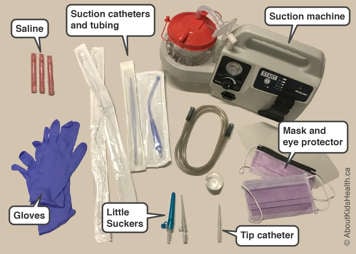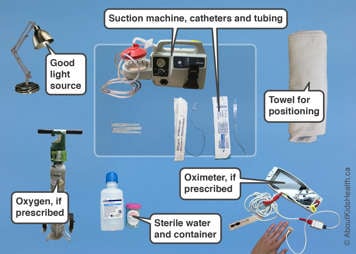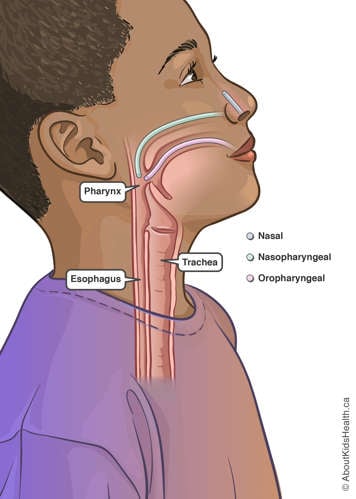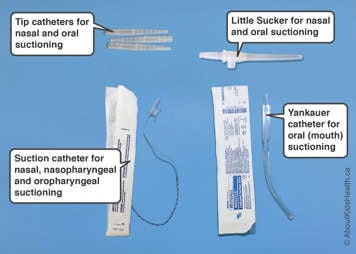Whichever method of suctioning you use, you should first be comfortable setting up the suction machine, gathering your equipment and knowing which size catheter to use.

Setting up the suction machine
- Connect the suction tubing to the canister.
- Check the suction pressure by turning on the unit and covering the end of the tubing with your finger. Look at the number on the gauge, and make sure it is the number set by your health-care provider. This should be checked each time before you suction.
- Pressure setting for neonates (newborn): 60-80 mmHg
- Pressure setting for infants: 80-100 mmHg
- Pressure setting for children/teens: 100-120 mmHg
- Attach the correct suction catheter, Yankauer or tip to the tubing.
- Proceed with suctioning.
What other equipment do I need for suctioning?

Additional equipment and supplies
- Sterile or distilled water
- Clean container for flushing solution
- Clean disposable gloves (to avoid direct contact with secretions from your child; sterile gloves are not needed)
- Water-based lubricant for nasopharyngeal suctioning
- Hand sanitizer
- Good light source
- Towel or small blanket for positioning if needed
- Oximeter and probes (if applicable)
- Oxygen, if needed
- Plastic bag for soiled supplies
What to look for when checking equipment
- Check your equipment every day to make sure that the:
- suction pressure is set
- filter is clean
- tubing is clean
- canister is clean
- machine is plugged in or battery is charged
- Ensure you have the correct size suction catheters.
Your child’s health-care professional will help you determine the best size catheter for your child. Please make note of the catheter size and the required pressure setting on the suction machine.
Types of suctioning

The following pages teach you how to do:
- nasal suctioning (suctioning in the nose)
- oral suctioning
- nasopharyngeal and oropharyngeal suctioning
Types of suctioning catheters
Different catheters may be used for nasal, oral, nasopharyngeal and oropharyngeal suctioning:
- Tip catheters are used for nasal and oral suctioning.
- Little Suckers are used for nasal and oral suctioning.
- Yankauer catheter is used for oral suctioning.
- A longer suction catheter can be used for nasal, nasopharyngeal and oropharyngeal suctioning, as seen in the image below.
